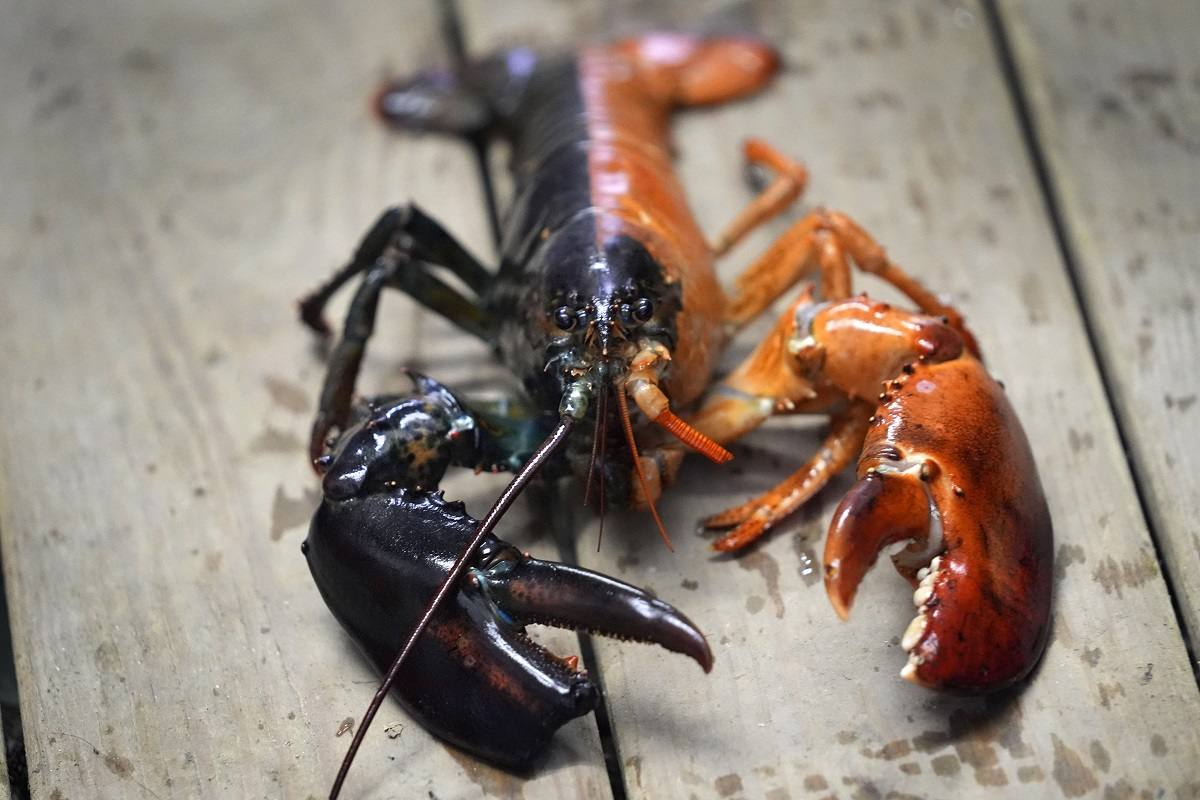Just How Rare is a Rare-Colored Lobster? Scientists Say Answer Could be under the Shell

A two-toned lobster is seen in a marine sciences lab at the University of New England, Thursday, Sept. 5, 2024, in Biddeford, Maine.
15:46 JST, September 8, 2024
BIDDEFORD, Maine (AP) — Orange, blue, calico, two-toned and … cotton-candy colored?
Those are all the hues of lobsters that have showed up in fishers’ traps, supermarket seafood tanks and scientists’ laboratories over the last year. The funky-colored crustaceans inspire headlines that trumpet their rarity, with particularly uncommon baby blue-tinted critters described by some as “cotton-candy colored” often estimated at 1 in 100 million.
A recent wave of these curious colored lobsters in Maine, New York, Colorado and beyond has scientists asking just how atypical the discolored arthropods really are. As is often the case in science, it’s complicated.
Lobsters’ color can vary due to genetic and dietary differences, and estimates about how rare certain colors are should be taken with a grain of salt, said Andrew Goode, lead administrative scientist for the American Lobster Settlement Index at the University of Maine. There is also no definitive source on the occurrence of lobster coloration abnormalities, scientists said.
“Anecdotally, they don’t taste any different either,” Goode said.
In the wild, lobsters typically have a mottled brown appearance, and they turn an orange-red color after they are boiled for eating. Lobsters can have color abnormalities due to mutation of genes that affect the proteins that bind to their shell pigments, Goode said.
The best available estimates about lobster coloration abnormalities are based on data from fisheries sources, said marine sciences professor Markus Frederich of the University of New England in Maine. However, he said, “no one really tracks them.”
Frederich and other scientists said that commonly cited estimates such as 1 in 1 million for blue lobsters and 1 in 30 million for orange lobsters should not be treated as rock-solid figures. However, he and his students are working to change that.
Frederich is working on noninvasive ways to extract genetic samples from lobsters to try to better understand the molecular basis for rare shell coloration. Frederich maintains a collection of strange-colored lobsters at the university’s labs and has been documenting the progress of the offspring of an orange lobster named Peaches who is housed at the university.
Peaches had thousands of offspring this year, which is typical for lobsters. About half were orange, which is not, Frederich said. Of the baby lobsters that survived, a slight majority were regular colored ones, Frederich said.
Studying the DNA of atypically colored lobsters will give scientists a better understanding of their underlying genetics, Frederich said.
“Lobsters are those iconic animals here in Maine, and I find them beautiful. Especially when you see those rare ones, which are just looking spectacular. And then the scientist in me simply says I want to know how that works. What’s the mechanism?” Frederich said.
He does eat lobster but “never any of those colorful ones,” he said.
One of Frederich’s lobsters, Tamarind, is the typical color on one side and orange on the other. That is because two lobster eggs fused and grew as one animal, Frederich said. He said that’s thought to be as rare as 1 in 50 million.
Rare lobsters have been in the news lately, with an orange lobster turning up in a Long Island, New York, Stop & Shop last month, and another appearing in a shipment being delivered to a Red Lobster in Colorado in July.
The odd-looking lobsters will likely continue to come to shore because of the size of the U.S. lobster fishery, said Richard Wahle, a longtime University of Maine lobster researcher who is now retired. U.S. fishers have brought more than 90 million pounds (40,820 metric tons) of lobster to the docks in every year since 2009 after only previously reaching that volume twice, according to federal records that go back to 1950.
“In an annual catch consisting of hundreds of millions of lobster, it shouldn’t be surprising that we see a few of the weird ones every year, even if they are 1 in a million or 1 in 30 million,” Wahle said.
"News Services" POPULAR ARTICLE
-

American Playwright Jeremy O. Harris Arrested in Japan on Alleged Drug Smuggling
-

Japan’s Nikkei Stock Average as JGB Yields, Yen Rise on Rate-Hike Bets
-

Japan’s Nikkei Stock Average Licks Wounds after Selloff Sparked by BOJ Hike Bets (UPDATE 1)
-

Japan’s Nikkei Stock Average Buoyed by Stable Yen; SoftBank’s Slide Caps Gains (UPDATE 1)
-

Japanese Bond Yields Zoom, Stocks Slide as Rate Hike Looms
JN ACCESS RANKING
-

Keidanren Chairman Yoshinobu Tsutsui Visits Kashiwazaki-Kariwa Nuclear Power Plant; Inspects New Emergency Safety System
-

Imports of Rare Earths from China Facing Delays, May Be Caused by Deterioration of Japan-China Relations
-

University of Tokyo Professor Discusses Japanese Economic Security in Interview Ahead of Forum
-

Japan Pulls out of Vietnam Nuclear Project, Complicating Hanoi’s Power Plans
-

Govt Aims to Expand NISA Program Lineup, Abolish Age Restriction























